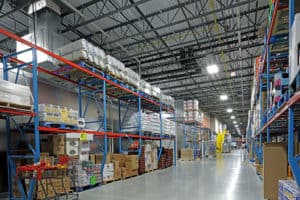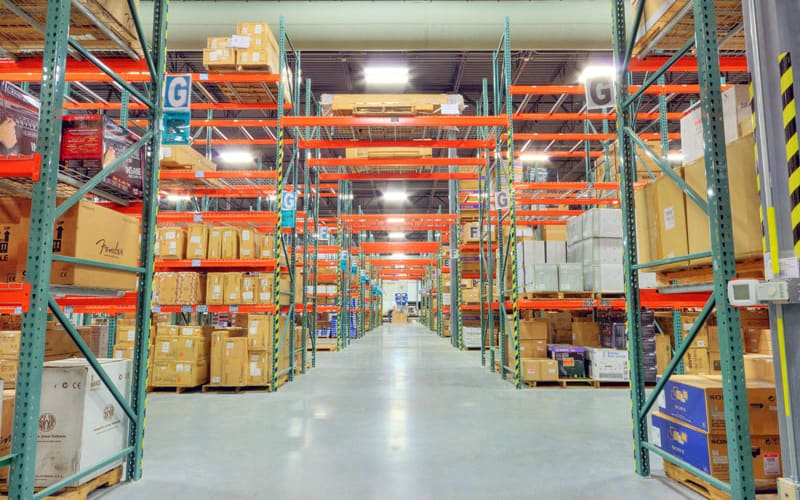INTRODUCTION
Automated Storage and Retrieval Systems (ASRS), also known as Goods-to-Person Picking Technology, are computer-controlled systems that store and retrieve items with minimized human contact.
Many warehouse and distribution center managers are turning to this technology to address inefficient use of space, slow pick rates or scarce labor. If your business is struggling from any of these issues, installing ASRS is a solution.
Before deciding if ASRS is right for you, take a look at the various types of ASRS and why industry leaders are rapidly adopting this technology:
TYPES OF AUTOMATED STORAGE AND RETRIEVAL SYSTEMS
 Shelf-based picking: Warehouses that store larger loads will benefit from shelf-based picking systems, which handle these loads and deliver them to operators. This in turn addresses limited space for accessible pallet-level storage. Types of shelf-based picking include vertical lift modules, horizontal and vertical carousels. Installing shelf-based picking for larger-load warehouses will maximize your storage density, reduce energy consumption and maximize throughput.
Shelf-based picking: Warehouses that store larger loads will benefit from shelf-based picking systems, which handle these loads and deliver them to operators. This in turn addresses limited space for accessible pallet-level storage. Types of shelf-based picking include vertical lift modules, horizontal and vertical carousels. Installing shelf-based picking for larger-load warehouses will maximize your storage density, reduce energy consumption and maximize throughput.
Bin-based picking: For warehouses with smaller items, bin-based picking is the best system because of its flexibility. They deliver smaller, individual bins or totes to operators via a vertical buffer module or crane-based mini-load system. If you have a range of small totes, boxes and containers but lack the floor space to have a pick face for each item, bin-based picking ASRS will increase storage density and adapt to the variety of items in your warehouse.
Robotic delivery: The most dynamic type of ASRS, robotic delivery takes the form of either robotic shuttles that travel over narrow rails from level to level, or a fleet of autonomous, mobile floor robots. If your warehouses lacks available workers or is looking to extend hours of operation, robots can meet your needs.
ASRS HELPS WITH EFFICIENCY
Installing ASRS will improve efficiency in multiple facets of your business, ultimately saving your bottom line in the long term.
First, ASRS gives you more floor space. According to a survey of warehouse and distribution center operations in 2015, 43 percent said one of the largest challenges their businesses face is insufficient space. ASRS addresses this issue by using the full floor-to-ceiling height of facilities and cutting wasted aisle space through high-density storage. The added space increases manufacturing capacity, allows for more inventory and provides opportunities for other ways of creating additional revenue.
ASRS also will improve speed and accuracy for your operation. Instead of a manual operation, which often only fills one order at a time, ASRS uses batch picking, a process that groups together multiple orders. ASRS also maintains data of every product, ensuring accurate inventory data and eliminating human error in data collection and retrieval. In fact, according to a survey by Robotics Business Review, automated warehouses were 76% more likely to boost inventory accuracy by 99% or higher.
In addition, ASRS makes the job more ergonomic for your workers. As you know, with manual storage and retrieval, workers often walk miles within a single shift, which is both inefficient and exhausting. With ASRS technology, workers stay in a work area, and the systems deliver the goods to them directly, leaving the heavy lifting to the automated system.
LOOK TO SAVE MONEY IN THE FUTURE WITH ASRS
While ASRS costs more up front, installing them ultimately pays off because of the money it saves your business.
Imagine you cut down your labor costs by 60%, and your operations can work through the night. ASRS also provides an effective solution to unreliable or scarce labor, an issue that many warehouse managers face.
However, robotics and automation technology do not necessarily need to lead to layoffs to improve profit. Rather than replacing jobs, robotics and automation actually increase labor productivity and has done so 0.35% annually, according to Harvard Business Review. If that does not seem like a lot, that increase in productivity is on the same level of impact as the steam engine between 1850 and 1910.
Installing ASRS also lets you better control your inventory, reducing costs from lost or stolen goods. Some ASRS systems can be configured to only allow authorized personnel to enter certain areas, ultimately decreasing unwanted contact and improving accountability. The fully enclosed inventory management system also decreases the likelihood of accidentally damaged items.
IMPROVE SAFETY USING ASRS
In 2016, there were five workplace injuries for every 100 full-time workers in the warehouse/ storage industry. Adopting ASRS can protect your workers from these types of injuries because this type of storage automation has your workers handling less-heavy and hazardous materials.
However, before adopting ASRS, you should make sure your facilities are up to par for the automated technology. Automated systems lack ability to spot issues that would cause a safety issue and create solutions, so system failures arise when factors do not meet the system’s preprogrammed conditions.
As a solution to this, remove variables that would cause ASRS safety issues. Ensure conditions are met by using materials that will not change due to the weather or other external factors. For example, use plastic pallets rather than wood as they are lighter and do not change dimensions (e.g. warp/decay).
Many warehouses are converted mills or other buildings, so at the structural level they may not always be ready to introduce automation safely. ASRS run on sensors, so skylights and other uneven lighting can cause glares that mess with the machines. Air conditioning systems may also need to be reconfigured because gusts of air can blow light packages off conveyor belts. Before adopting ASRS, check to see if your building needs renovations.
FOR MORE INFORMATION
FoxArneson specializes in both design and building services for warehouse and distribution centers.

